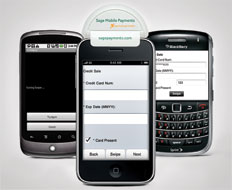With smartphones getting smarter, smaller, and speedier all the time, concurrent advances in mobile point-of-sale technology are presenting restaurants with the opportunity to make their POS systems mobile.
There are now numerous POS platforms that leverage the iPhone and other mobile devices, including Android-powered smartphones and tablet computers like the iPad, so that restaurants can process payments in the field with a credit-card reader. The readers either attach to mobile devices of the operator’s choice or accept payment through mobile applications like Google Wallet.
These various platforms, experts say, liberate restaurants from the constraints and costs of traditional POS systems and open up game-changing new ways to capture information about customers that will help operators earn their loyalty.
“This technology gives restaurants a degree of freedom,” says Mike English, a mobile payments experts at Heartland Payment Systems, which processes nearly one in seven transactions in the restaurant industry. “Traditional POS has been very regimented and costly, but mobile is very adaptable, not only in terms of payment but in terms of marketing tools from an ever-growing number of third parties.”
While mobile POS is often touted as a boon to full-service restaurants—it can allow customers to pay at the table through a credit-card reader attached to a mounted iPad, for example, and waiters can log orders on a smartphone that zip back to the kitchen at 4G speed—the technology also has service-oriented benefits for quick serves, English says.
“In [quick serves], we see mobile devices being used for line busting,” he says. “If it is lunch time and customers are waiting in a long line, they are a lot less likely to walk away if they see the restaurant open up another [payment option].”
Beyond mobile POS’s value as a portable cash register is its potential as a conduit for invaluable consumer insight. Whereas restaurants are able to glean very little personalized information from credit-card transactions, they can learn a lot when customers use the mobile payment apps or opt in for an array of alerts and updates via their smartphones.
“I would go as far as to say that merchants have almost zero knowledge of their customers from a credit card,” says Paul Cwalina, a senior vice president at First Data, which processes payments for millions of businesses and helps power Google Wallet, the Internet giant’s foray into mobile payment. “They can see that a 16-digit number that ends in 1234 comes in twice a week or twice a month. Beyond that, they can’t do anything with it … because the bank keeps all of our information confidential. So it doesn’t really give merchants good data.”
Mobile, on the other hand, allows operators to parse customer behavior.
“The mobile POS … allows us to capture valuable data that gives us a better idea of our customers’ spending and buying habits,” says Charles Smith, owner of Chuck’s Wagon BBQ. The restaurant and catering operation based in Bowie, Maryland, uses a mobile POS platform called Sage Payment Solutions for processing credit cards in the field and for tracking sales in general. “For example, we know that if offered the opportunity to use a card versus cash, the card user is likely to spend more.”
These kind of granular insights are hard to cull from analyzing credit-card transactions alone, Cwalina says. “The big thing is that people don’t share cell-phone numbers” as they do credit-card numbers, he says. “My wife has a different [phone] number than I do, and she is obviously a different person with different spending habits, and so [businesses] can talk to her one way and to me another way.”
Smartphones open up very exciting opportunities when it comes to business-consumer communication, the experts say. As mobile POS technology evolves, an operator will be able to send coupons to opted-in customers’ phones based on their shopping habits or geographic location. They will also be able to offer sophisticated, mobile-based loyalty programs that will leverage social media and ditch paper punch cards.
“We’re thinking about how businesses currently interact with the consumer and figuring out how we can better connect them,” says Travis Kellerman, a manager at POSLavu, which makes point-of-sale software for the iPhone and iPad.
Of course, communication is a two-way street, and that means restaurants need to be very careful not to bombard their customers with messages. Otherwise, they could experience a backlash in the form of miffed tweets and Facebook postings.
“The old days of businesses dictating to consumers are over,” Cwalina says. “There is a danger of too many texts, too many coupons. The mobile device is great, but I think there is definitely a danger of people getting too much on their phone.”
At the moment, though, the potential of mobile POS far outweighs the peril. The technology is in its infancy, and new developments are on the horizon. These include near-field communication, which allows smartphones to share data with other devices that are in close physical proximity, and EMV cards, which have microchips that allow them to interface with mobile phones.
Restaurants may not have a choice but to adapt and adopt, Cwalina says.
“I think it’s going to become a way of life,” he says about mobile payment. “Credit cards are going to be used more rarely, and mobile is going to happen a lot faster than plastic. This is not a fad.
“In baseball analogy,” he adds, “mobile technology is in the first inning.”













